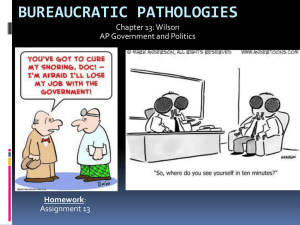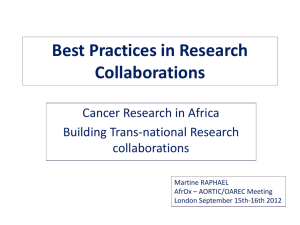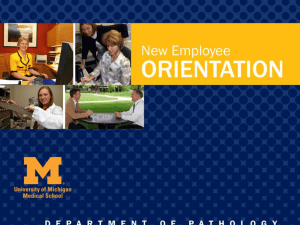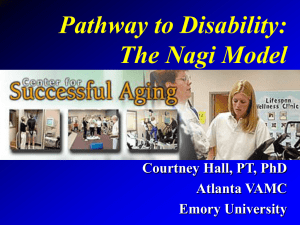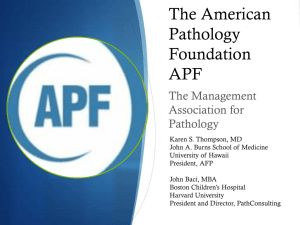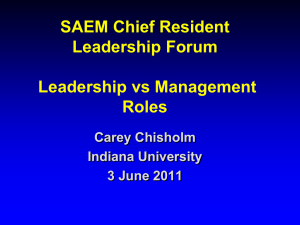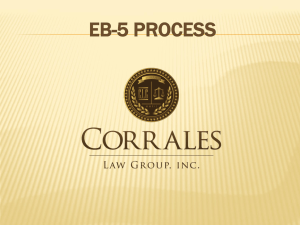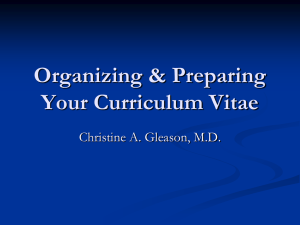Path Int Grp 2
advertisement
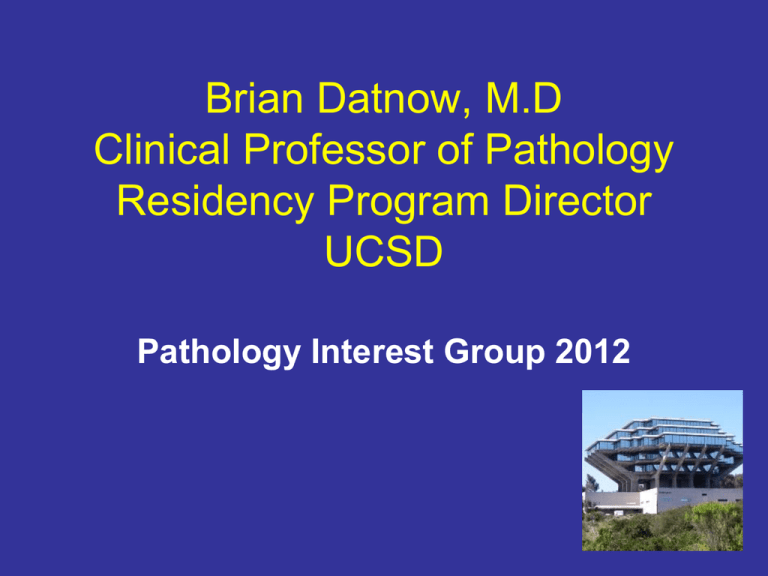
Brian Datnow, M.D Clinical Professor of Pathology Residency Program Director UCSD Pathology Interest Group 2012 What % of medical treatment is based on results produced by the Department of Pathology? • • • • • A 10% B 30% C 50% D 70% E 90% Answer D. 70% What is Pathology? • Diagnostic Medicine • Teaching Medical Students Residents & Fellows Graduate Students Fellow Physicians • Basic & Clinical Research into Mechanisms of Disease AIMS OF PATHOLOGY AS A DISCIPLINE • To further our understanding of the mechanisms of disease, and, in so doing, allow for a more effective treatment strategies • To consult with clinical colleagues in the care of patients so that laboratory information is effectively and properly integrated into diagnosis & treatment planning; in this context, pathologists must be knowledgeable about clinical findings and data from virtually all other specialty areas Rudolph Virchow (1821-1902) Originator of modern pathology theory Paul Ehrlich (1854-1915) Changes in body fluid led to the development of clinical chemistry and hematology • • • • • • • • • • • • • • MODERN SUBSPECIALTIES IN PATHOLOGY Surgical pathology Autopsy & forensic pathology Cytopathology Neuropathology Pediatric pathology Dermatopathology Hematopathology Clinical chemistry Microbiology & infectious disease Transfusion medicine Diagnostic immunopathology Cytogenetics Molecular diagnostics Genomics (personalized medicine) Diagnoses in Anatomic Pathology A Continuing Goal & Major Focus of Translational Research • • • • • • • Morphology Flow Cytometry Electron microscopy Immunohistochemistry In-situ hybridization Nucleic acid blotting technologies Genomics Techniques in Pathology • • • • • • • • • • • • • • • • • • Patient-Related Fine needle aspiration biopsy Apheresis Bone marrow aspiration & biopsy Procedural Frozen section Autopsy Prosection of gross specimens Light, polarization, & phase-contrast microscopy Electron microscopy Immunohistology In-situ hybridization & comparative genomic hybridization Flow cytometry Cytogenetics Chromatography Polymerase chain reaction & nucleic acid blotting technologies Mass spectroscopy Spectrophotometry Bacterial, mycological, & viral cultures Differential microbial biochemistry What and How Long are the Training Programs? • • • • Anatomic & Clinical Pathology (4y) Anatomic Pathology (3y) Clinical Pathology (3y) Research Pathology (lifetime) 85%* 10% 3% 1% * Percentage of pathways pursued by trainees Pathology Training Programs Resident Workload Avg. Weekly Workload 48.3 hours Avg. Annual Compensation $32,000-$56,000 (UCSD $45,000-$56,000) Avg. Vacation 3.1 weeks (UCSD 4 weeks) AMA FRIEDA, Training Program Survey, 2007 Pathology Training Programs Total # of Residents Avg. # per Program Avg % Female Avg % IMGs AMA FRIEDA, Training Program Survey, 2007 2,500 14.3 49.7% 57.1% Pathology Specialties (Fellowship Training) Anatomic Pathology: • Cytopathology • Dermatopathology • Gynecologic Pathology • Breast Pathology • Neuropathology • Pediatric Pathology • Gastrointestinal • Bone & Soft Tissue • Head & Neck • Lung • Urologic Pathology Pathology Specialties (Fellowship Training) Clinical Pathology: • Hematopathology • Microbiology • Transfusion Medicine • Cytogenetics • Clinical Chemistry • Nuclear Medicine • Molecular Medicine Pathology Specialties (Fellowship Training) • • • • Forensic Pathology Hematopathology Molecular Diagnostics Informatics What are the Career Options for Pathologists? • Community Practice (80%) • Academic Practice & Medical School Administration (15%) • Industry (3%) • Government, Public Health & Regulatory Positions, e.g., FDA (1%) Pathology Practice Demographics Type of Practice • Solo • Pathology Group • Multispecialty Group • Medical School • Hospital • Independent Laboratory • Locum Tenens 7% 67% 7% 10% 10% 9% 1% College of American Pathologists Survey, N=940 Pathology Workload Mean hours per week 48 hrs • Surgical Pathology 25.0 • Cytopathology 5.9 • Billable Clinical Pathology 2.6 • Clinical Pathology Management 7.4 • Teaching/Research 1.9 • Autopsy 2.1 • Other 3.1 Mean Total, Other Medical Specialties College of American Pathologists Survey, N=940 55 hrs Pathology Salaries Median Income by Age • All Ages $220,000 • < 40 $180,000 • 40 – 49 $230,000 • 50 – 59 $250,000 • >59 $200,000 Latest data (2011) for all ages $325,000 What is the Lifestyle of Pathologists? • 48 hour work week vs. 55 hour average work week all specialties • Above average professional satisfaction (70%) • Above average family satisfaction • Average professional respect • Below average stress Current & Future Career Opportunities • Starting salary offers over $125,000 – above primary care specialties, slightly below surgical specialties • Two offers for each graduating candidate; higher for U.S. graduates • 20,000 Board-Certified Pathologists U.S.; 2,500 in training (800,000 physicians in U.S.) • Anticipated increased job opportunities in five years Current & Future Career Opportunities • Every academic department in U.S. has a vacancy (130 medical schools; 155 training programs) • Pathology Departments have $400 million in NIH research grants – more than many NIH institutes (Special Opportunities for Physician Scientists) • Diagnostic Medicine: $35 billion market, growth 5-7% annually Residency Positions and Funding • Nineteen (19) residency positions (ACGME certified) • Six (6) openings for 2011-2012 Thirteen (13) funded by the hospital Six (6) funded by the VAMC • One (1) *Neuropathlogy Fellowship (2 year) • One (1) Research Fellowship (1 year) • Four (4) Surgical Pathology Fellowships ( I year) • One (1) *Hematopathology Fellowship ( I year) • One *Cytopathology Fellowship (2013) ( I year) * Designates ACGME/ABP recognized. Other Fellowships in San Diego • Hematopathology at Scripps-Green • Forensic Pathology (ME) UCSD Pathology Residency Training Experience • • • • • • UCSD Hillcrest UCSD Thornton UCSD Moore’s Cancer Center UCSD CALM VAMC Also at affiliated UCSD laboratories and other affiliated institutions Affiliated Medical Centers • Veterans Affairs Medical Center (structured rotations in AP and CP) • Rady Children’s Hospital Medical Center (structured rotations in Pediatric Pathology) • Medical Examiner of San Diego County (structured rotations in Forensic Pathology) • Kaiser Permanente Medical Center (elective rotations in Surgical Pathology and Cytopathology) • United States Naval Hospital (elective rotations in Hematopathology, Surgical Pathology and Cytopathology) • Green Hospital at Scripps Clinic (elective rotations in Hematopathology) Pathology Disciplines Anatomic Pathology Autopsy Pathology Cytopathology Forensic Pathology Neuropathology Surgical Pathology Pathology Disciplines Clinical Pathology Clinical Chemistry Coagulation Cytogenetics Flow Cytometry Hematology Immunization and Transplantation Microbiology Molecular Pathology Toxicology Transfusion Medicine Accreditation Council for Graduate Medical Education (ACGME) • Accreditation of all residency and most fellowship programs • Divided into RRCs (Residency Review Committees) which are specific for each specialty • The Pathology RRC is comprised of Pathologists and non-Pathologist ACGME personnel ACGME and ABP Training Requirements APCP-4 programs must include 18 months of formal education in anatomic pathology and 18 months of formal education in clinical pathology. • The AP-3 and CP-3 programs must include 24 months of anatomic pathology (AP-3) or clinical pathology (CP-3) education. • The remaining 12 months of training for APCP-4, AP-3, and CP-3 programs may be a continuation of structured anatomic pathology or clinical pathology education, or may be devoted to a specialized facet of pathology. Residency Options Combined Anatomic Pathology (AP) and Clinical Pathology (CP) Four (4) year program includes 24 months of AP and 24 months of CP. At the completion of training, the resident will be board eligible in AP and CP. Residency Options AP only Three (3) year program. At the completion of training, the resident will be board eligible in AP. Residency Options CP only Three (3) year program. At the completion of training, the resident will be board eligible in CP. Interview Process • Morning interviews with 4-6 faculty members (AP and CP, UCSD and VAMC) for 4-6 applicants 0800-0900: Introduction by chair and program director 0900-1100: Interviews • Tour of UCSD Hillcrest Hospital with chief or senior resident • Transportation to campus • Lunch with the residents • Tour of Moore’s Cancer Center, Thornton Hospital and VAMC with chief or senior resident • Visit ends • Feedback from applicants has been positive 2010 Match Applicants • • • • • • Number of applicants: 234 Number with MD., PhD: 20 UCSD Graduates: 3 US Graduates: 138 International graduates: 96 USMLE scores: Step I 99th percentile: 40 Step I and II 99th percentile: 26 • Number interviewed: 68 (14 IMGs) • Number ranked: 61 Criteria for Selection • Demonstrated interest in Pathology • Completion of USMLE Step I with score >85th percentile • Solid letters of recommendation preferably from Pathologists • Solid grades in Medical School especially subjects related to Pathology • Satisfactory Dean’s letter • Ability to work with others • Good communication skills Anatomic Pathology Activities in Which Medical Students Can Participate • Gross examination & prosection of surgical pathology specimens • Frozen sections • Autopsies • Microscopy & case signout Where to go & what to do next? To learn more about pathology: • • • • • • • www.apcprods.org www.asip.org www.uscap.org www.ascp.org/member/rps/ www.aclps.org www.cap.org/html/member/residents_forum.html www.aamc.org/students/considering/start.htm Where to go & What to do next? For information about pathology training and fellowships: • • • • www.abppath.org www.pathologytraining.org www.acgme.org www.amaassn.org/ama/pub/category/2997. html (FREIDA On Line) Where to go & What to do next? To find out about individual training or fellowship programs: • • • • www.pathologytraining.org www.apcprods.org www.university.edu www.medical_school.edu/pathology “To know Pathology is to know Medicine” Sir William Osler
